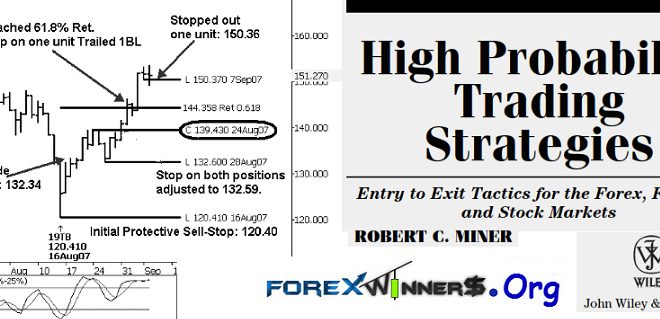High Probability Trading Strategies Entry to Exit Tactics by Robert C. Miner
Entry to Exit Tactics for the Forex, Futures, and Stock Markets
John Wiley & Sons, Inc.
This book is unique. Unlike most trading books, it will teach you a complete trading plan from entry to exit. Not a few well-chosen examples of isolated trade setups and strategies, but exactly how to recognize optimal trade conditions, objective entry strategies with the exact entry and exit price, and how to manage the trade with stop-loss adjustments to the trade exit.
The majority of trading books focus on a few techniques and show a plethora of carefully chosen examples to support whatever is being taught. Some of the phrases often used are “You could have bought around here or taken profit around here”; “depending on whether you are a conservative or aggressive trader, you could do . …(this or that)”; “markets usually fluctuate around the volatility band, which is a good place to buy or sell”; and lots more nonspecific statements.
Brokers don’t take orders “around this or that price level.” They only take specific price orders. There is no such thing as a conservative or aggressive trader. There are only traders who either follow a trading plan or don’t. To maybe do this or that “around” a volatility band or any other indicator or chart position is not a trade strategy. A trade strategy is a specific action to take, including the specific buy and sell price. In other words, worthwhile instruction will teach you exactly what to do and how and when to do it.
While many trading books do teach some useful specific trading techniques or at least provide some ideas to explore, it is very unusual for a book or any other type of trading course to teach exactly what to do, from how to recognize a trading opportunity, to the exact entry and stop price, and how to manage the trade until it is closed out.
That is what this book does. It will teach you a high probability trade plan with specific strategies from entry to exit. Most important, it will teach you how to think about the four key factors of momentum, pattern, price, and time; how to recognize what is useful and relevant market information that can be used to make a specific trade decision; and then how to execute the trade decisions from entry to exit.
The trade strategies you will learn in this book may be used for any actively traded market and any time frame. Stocks, exchange-traded funds (ETFs), futures, and Forex examples are used. The same market structure is made day in and day out in all of these markets and in all time frames, from monthly to intraday data. If an example is not a market or time frame you typically trade, ignore the symbol and focus on what is to be learned. The strategy taught will apply to all markets and time frames.
Contents :
CHAPTER 1 High Probability Trade Strategies for Any Market and Any Time Frame
Any Market, Any Time Frame
Conditions with a High Probability Outcome
Leading and Lagging Indicators
What You Will Learn in This Book and CD
Let’s Get Started
CHAPTER 2 Multiple Time Frame Momentum Strategy
What Is Momentum?
Multiple Time Frame Momentum Strategies
The Basic Dual Time Frame Momentum Strategy
Momentum Reversals
Most Price Indicators Represent Rate-of-Change
Momentum and Price Trends Often Diverge
How Dual Time Frame Momentum Strategies Work
Which Indicators to Use for Multiple Time Frame
Momentum Strategies
What Are the Best Indicator Settings to Use?
Dual Time Frame Momentum Strategy Rules
Dual Time Frame Momentum Strategy Trade Filter
CHAPTER 3 Practical Pattern Recognition for Trends and Corrections
Why Is It Important to Identify a Trend or Correction?
Simple Pattern Recognition Based On Elliott Wave
Trend or Correction: The Overlap Guideline
ABC and Away We Go
Complex Corrections
Overlap Is the Key to Identify a Correction
Trends and Five-Wave Patterns
Greater in Time and Price
Fifth Waves Are the Key
Momentum and Pattern Position
Momentum and Pattern Not Enough
CHAPTER 4 Beyond Fib Retracements
Internal Retracements and Corrections
Alternate Price Projections Qualify Internal
Retracements
More Alternate Price Projections
External Retracements Help Identify the Final Section of
a Trend or Correction
Pattern Price Targets
Price, Pattern, and Momentum
No Excuse
CHAPTER 5 Beyond Traditional Cycles
Time Retracements and Corrections
Alternate Time Projections Narrow the Time
Retracement Range
More Time Factors
The Time Target Zone
Time Bands
More Time Factors
Conclusion
CHAPTER 6 Entry Strategies and Position Size
Entry Strategy 1: Trailing One-Bar Entry and Stop
Entry Strategy 2: Swing Entry and Stop
CHAPTER 7 Exit Strategies and Trade Management Multiple-Unit Trading
Risk/Reward Ratios
Exit Strategies
Trade Management
Trade Only the High Probability, Optimum Setups
PART TWO Trading the Plan
CHAPTER 8 Real Traders, Real Time
Adam Sowinski (Slorzewo, Poland)
Jagir Singh (London, United Kingdom)
Cees Van Hasselt (Breda, The Netherlands)
Kerry Szymanski (Tucson, Arizona)
Derrik Hobbs (Warsaw, Indiana)
Carolyn Boroden (Scottsdale, Arizona)
Jaime Johnson (Encinitas, California, and
Bogata, Columbia)
Chapter Summary
CHAPTER 9 The Business of Trading and Other Matters
Routines and Trading Records
Why Traders Win or Lose
Technology, Trading Time Frames, Markets to Trade, and Leverage
Trade for Points, Not for Ticks
You Can’t Buy Success
You CAN Be a Successful Trader
 Forex Winners | Free Download Downlod free trading sysrems , indicators and forex E-books
Forex Winners | Free Download Downlod free trading sysrems , indicators and forex E-books

